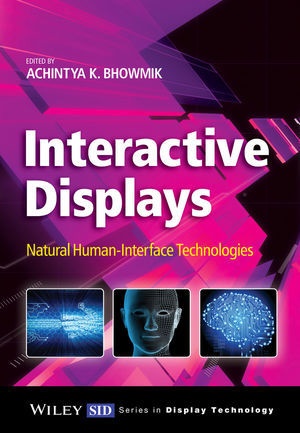Read more
How we interface and interact with computing, communications and entertainment devices is going through revolutionary changes, with natural user inputs based on touch, voice, and vision replacing or augmenting the use of traditional interfaces based on the keyboard, mouse, joysticks, etc. As a result, displays are morphing from one-way interface devices that merely show visual content to two-way interaction devices that provide more engaging and immersive experiences. This book provides an in-depth coverage of the technologies, applications, and trends in the rapidly emerging field of interactive displays enabled by natural human-interfaces.
Key features:
* Provides a definitive reference reading on all the touch technologies used in interactive displays, including their advantages, limitations, and future trends.
* Covers the fundamentals and applications of speech input, processing and recognition techniques enabling voice-based interactions.
* Offers a detailed review of the emerging vision-based sensing technologies, and user interactions using gestures of hands, body, face, and eye gazes.
* Discusses multi-modal natural user interface schemes which intuitively combine touch, voice, and vision for life-like interactions.
* Examines the requirements and technology status towards realizing "true" 3D immersive and interactive displays.
List of contents
About the Author xiii
List of Contributors xv
Series Editor's Foreword xvii
Preface xix
List of Acronyms xxi
1 Senses, Perception, and Natural Human-Interfaces for Interactive Displays 1
Achintya K. Bhowmik
1.1 Introduction 1
1.2 Human Senses and Perception 4
1.3 Human Interface Technologies 9
1.3.1 Legacy Input Devices 9
1.3.2 Touch-based Interactions 11
1.3.3 Voice-based Interactions 13
1.3.4 Vision-based Interactions 15
1.3.5 Multimodal Interactions 18
1.4 Towards "True" 3D Interactive Displays 20
1.5 Summary 23
References 24
2 Touch Sensing 27
Geoff Walker
2.1 Introduction 27
2.2 Introduction to Touch Technologies 28
2.2.1 Touchscreens 30
2.2.2 Classifying Touch Technologies by Size and Application 30
2.2.3 Classifying Touch Technologies by Materials and Structure 32
2.2.4 Classifying Touch Technologies by the Physical Quantity Being Measured 33
2.2.5 Classifying Touch Technologies by Their Sensing Capabilities 33
2.2.6 The Future of Touch Technologies 34
2.3 History of Touch Technologies 35
2.4 Capacitive Touch Technologies 35
2.4.1 Projected Capacitive (P-Cap) 35
2.4.2 Surface Capacitive 47
2.5 Resistive Touch Technologies 51
2.5.1 Analog Resistive 51
2.5.2 Digital Multi-touch Resistive (DMR) 57
2.5.3 Analog Multi-touch Resistive (AMR) 59
2.6 Acoustic Touch Technologies 61
2.6.1 Surface Acoustic Wave (SAW) 61
2.6.2 Acoustic Pulse Recognition (APR) 64
2.6.3 Dispersive Signal Technology (DST) 67
2.7 Optical Touch Technologies 68
2.7.1 Traditional Infrared 68
2.7.2 Multi-touch Infrared 73
2.7.3 Camera-based Optical 76
2.7.4 In-glass Optical (Planar Scatter Detection - PSD) 81
2.7.5 Vision-based Optical 82
2.8 Embedded Touch Technologies 86
2.8.1 On-cell Mutual-capacitive 89
2.8.2 Hybrid In-cell/On-cell Mutual-capacitive 90
2.8.3 In-cell Mutual-capacitive 91
2.8.4 In-cell Light Sensing 93
2.9 Other Touch Technologies 96
2.9.1 Force-sensing 96
2.9.2 Combinations of Touch Technologies 98
2.10 Summary 98
2.11 Appendix 100
References 101
3 Voice in the User Interface 107 Andrew Breen, Hung H. Bui, Richard Crouch, Kevin Farrell, Friedrich Faubel, Roberto Gemello, William F. Ganong III, Tim Haulick, Ronald M. Kaplan, Charles L. Ortiz, Peter F. Patel-Schneider, Holger Quast, Adwait Ratnaparkhi, Vlad Sejnoha, Jiaying Shen, Peter Stubley and Paul van Mulbregt
3.1 Introduction 107
3.2 Voice Recognition 110
3.2.1 Nature of Speech 110
3.2.2 Acoustic Model and Front-end 112
3.2.3 Aligning Speech to HMMs 113
3.2.4 Language Model 114
3.2.5 Search: Solving Crosswords at 1000 Words a Second 115
3.2.6 Training Acoustic and Language Models 116
3.2.7 Adapting Acoustic and Language Models for Speaker Dependent
Recognition 116
3.2.8 Alternatives to the "Canonical" System 117
3.2.9 Performance 117
3.3 Deep Neural Networks for Voice Recognition 119
3.4 Hardware Optimization 122
3.4.1 Lower Power Wake-up Computation 122
3.4.2 Hardware Optimization for Specific Computations 123
3.5 Signal Enhancement Techniques for Robust Voice Recognition 123
3.5.1 Robust Voice Recognition 124
3.5.2 Single-channel No
About the author
Achintya K. Bhowmik, Intel Corporation, USA
Dr. Achin Bhowmik is the director of perceptual computing technology and solutions at Intel Corporation, where his group is focused on developing next-generation computing solutions based on natural human-computer interaction and visual computing technologies and applications. He is a senior member of the IEEE as well as program committee member of SID and IMID. He is associate editor of the Journal of the Society for Information Display, and was guest editor for two special volumes on "Advances in OLED Displays" and "Interactive Displays". Dr. Bhowmik is an Adjunct Professor at Kyung-Hee University, Seoul, Korea teaching courses on digital imaging & display, digital image processing and optics of liquid crystal displays. He is on the board of directors for OpenCV, the organization behind the open source computer vision library.
Summary
How we interface and interact with computing, communications and entertainment devices is going through revolutionary changes, with natural user inputs based on touch, voice, and vision replacing or augmenting the use of traditional interfaces based on the keyboard, mouse, joysticks, etc.

